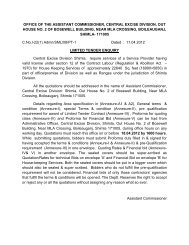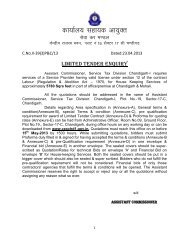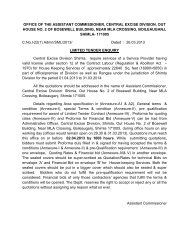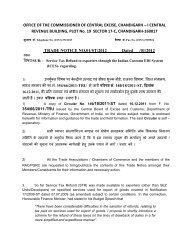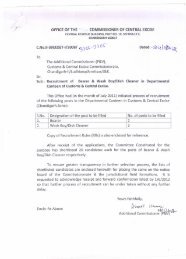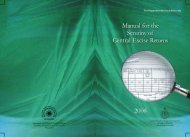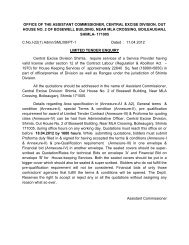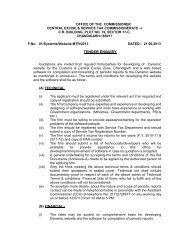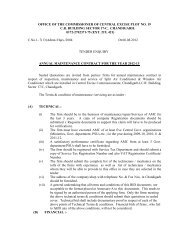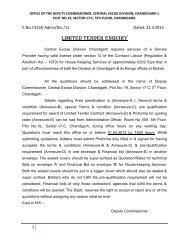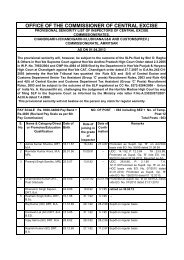Manual for Scrutiny of Service Tax Returns 2009 - Central Excise ...
Manual for Scrutiny of Service Tax Returns 2009 - Central Excise ...
Manual for Scrutiny of Service Tax Returns 2009 - Central Excise ...
- No tags were found...
You also want an ePaper? Increase the reach of your titles
YUMPU automatically turns print PDFs into web optimized ePapers that Google loves.
For Departmental circulation only<strong>Manual</strong> <strong>for</strong> <strong>Scrutiny</strong><strong>of</strong> <strong>Service</strong> <strong>Tax</strong> <strong>Returns</strong><strong>2009</strong><strong>Central</strong> Board <strong>of</strong> <strong>Excise</strong> and CustomsMinistry <strong>of</strong> FinanceGovernment <strong>of</strong> IndiaMANUAL FOR SCRUTINY OF SERVICE TAX RETURNS <strong>2009</strong>
iiMANUAL FOR SCRUTINY OF SERVICE TAX RETURNS <strong>2009</strong>
ContentsPrefaceivCHAPTER 1: Introduction I.11.1 Self Assessment and <strong>Returns</strong>’ <strong>Scrutiny</strong> I.11.2 Business Process Re-engineering and <strong>Returns</strong>’ <strong>Scrutiny</strong> I.11.2.1 Purpose <strong>of</strong> <strong>Scrutiny</strong> <strong>of</strong> <strong>Returns</strong> I.21.2.2 Authority and Ownership I.31.2.3 Distinction between Audit and <strong>Returns</strong>’ <strong>Scrutiny</strong> I.31.3 Conclusion I.4CHAPTER 2: Policy Guidelines <strong>for</strong> <strong>Returns</strong>’ <strong>Scrutiny</strong>2.1 What to Check <strong>for</strong> in the Preliminary <strong>Scrutiny</strong> <strong>of</strong> <strong>Service</strong> <strong>Tax</strong> <strong>Returns</strong> II.12.2 Processing Guidelines issued by the Board <strong>for</strong> the Preliminary <strong>Scrutiny</strong> <strong>of</strong> <strong>Returns</strong> II.12.3 Guidelines <strong>for</strong> Selecting ST-3 <strong>Returns</strong> <strong>for</strong> Detailed <strong>Scrutiny</strong> II.2Annexe 2.1 Format <strong>for</strong> Preliminary <strong>Scrutiny</strong> <strong>of</strong> ST-3 <strong>Returns</strong> A II.1.1Annexe 2.2 Risk Parameters <strong>for</strong> Detailed <strong>Scrutiny</strong> A II.2.1Annexe 2.3 Mini Risk Parameters <strong>for</strong> Selection <strong>of</strong> a Return <strong>for</strong> Detailed A II.3.1<strong>Scrutiny</strong>, in a System Assisted Business ProcessCHAPTER 3: Automated <strong>Scrutiny</strong> <strong>of</strong> <strong>Returns</strong>3.1 Processes Identified in the Automated <strong>Returns</strong>’ <strong>Scrutiny</strong> in Respect <strong>of</strong> ST-3 III.13.1.1 Marking an ST-3 return <strong>for</strong> review III.23.1.2 Action to be taken when an ST-3 return is highlighted <strong>for</strong> review III.33.2 Selection <strong>of</strong> <strong>Returns</strong> <strong>for</strong> Detailed <strong>Scrutiny</strong> through ACES III.4CHAPTER 4: Guidelines <strong>for</strong> Detailed <strong>Scrutiny</strong>4.1 Introduction IV.14.2 Guidelines <strong>for</strong> Selection <strong>of</strong> <strong>Returns</strong> <strong>for</strong> Detailed <strong>Scrutiny</strong> IV.14.3 <strong>Scrutiny</strong> Guidelines IV.24.3.1 Features <strong>of</strong> the Checklist IV.24.3.2 Documentation <strong>of</strong> Findings Flowing Fromthe <strong>Scrutiny</strong> <strong>of</strong> AssessmentIV.34.3.3 Administrative Arrangements IV.3Annexe 4.1 Checklist <strong>for</strong> Detailed <strong>Manual</strong> <strong>Scrutiny</strong> <strong>of</strong> ST-3 <strong>Returns</strong> A IV.1.1Annexe 4.2 Guidelines <strong>for</strong> seeking in<strong>for</strong>mation A IV.2.1Annexe 4.3 Observation Sheet <strong>for</strong> Documenting <strong>Scrutiny</strong> Findings A IV.3.1Annexe 4.4 Glossary <strong>of</strong> Accounting Terms A IV.4.1MANUAL FOR SCRUTINY OF SERVICE TAX RETURNS <strong>2009</strong>II.1III.1IV.1iii
Preface1. The introduction <strong>of</strong> self assessment in <strong>Service</strong> <strong>Tax</strong> in July 2001 necessitated the introduction<strong>of</strong> a system <strong>of</strong> returns’ scrutiny. <strong>Returns</strong>’ scrutiny is there<strong>for</strong>e a key business process andis one <strong>of</strong> the three important prongs <strong>of</strong> the compliance verification system comprisingreturns’ scrutiny, audit, and anti-evasion.2. The <strong>Manual</strong> <strong>for</strong> <strong>Scrutiny</strong> <strong>of</strong> <strong>Service</strong> <strong>Tax</strong> <strong>Returns</strong> seeks to put into place a two-part system<strong>of</strong> returns’ scrutiny—a preliminary scrutiny system covering all the returns and a detailedscrutiny system covering a few returns selected on the basis <strong>of</strong> risk parameters. This manualseeks to standardize checks <strong>for</strong> carrying out detailed scrutiny. It is visualized that thepreliminary scrutiny system would be automated shortly.3. The <strong>Manual</strong> <strong>for</strong> <strong>Scrutiny</strong> <strong>of</strong> <strong>Service</strong> <strong>Tax</strong> <strong>Returns</strong> is organized into four chapters. Chapter1 outlines the rationale <strong>for</strong> returns’ scrutiny and discusses the legislative provisions underpinningthe scrutiny process. The chapter also looks at the critical distinction between auditand returns’ scrutiny as key differentiated business processes. Chapter 2 examines the policyguidelines covering returns’ scrutiny and discusses the risk parameters to be employed <strong>for</strong>selecting returns <strong>for</strong> detailed scrutiny. The logic embedded in these risk parameters would beincorporated into the s<strong>of</strong>tware which would facilitate system-based selection <strong>of</strong> returns <strong>for</strong>detailed scrutiny. Chapter 3 looks at the salient features <strong>of</strong> the ACES project (Automation <strong>of</strong><strong>Central</strong> <strong>Excise</strong> and <strong>Service</strong> <strong>Tax</strong>) which, when implemented, would automate the preliminaryscrutiny process. Finally, Chapter 4 presents guidelines <strong>for</strong> carrying out the detailed scrutiny<strong>of</strong> selected returns. This chapter contains detailed guidelines <strong>for</strong> ensuring correctness <strong>of</strong>assessment and reconciling the in<strong>for</strong>mation given in the statutory <strong>Service</strong> <strong>Tax</strong> return with thein<strong>for</strong>mation furnished in the financial records. Chapter 4 also contains guidelines <strong>for</strong>documenting the scrutiny findings in an observation sheet. This observation sheet wouldcontain a record <strong>of</strong> the findings <strong>of</strong> the scrutiny <strong>of</strong>ficers on whether any action needs to betaken post scrutiny <strong>for</strong> referral either to audit or to anti-evasion <strong>for</strong> further investigation <strong>for</strong>seeking a closure.4. Like all manuals, this manual is visualized as an evolving document which will benefitfrom periodic updation on the basis <strong>of</strong> feedback received from the field <strong>for</strong>mations.This manual has been prepared as part <strong>of</strong> the Asian Development Bank’s Technical Assistance Project (IND: TA 4263) titled‘Capacity Building <strong>for</strong> <strong>Tax</strong> Administration’.ivMANUAL FOR SCRUTINY OF SERVICE TAX RETURNS <strong>2009</strong>
Chapter 1: Introduction1.1 SELF ASSESSMENT AND RETURNS’ SCRUTINY1.1A The introduction <strong>of</strong> self assessment in <strong>Service</strong> <strong>Tax</strong> in July 2001 was a defining moment<strong>for</strong> the Indian taxation system as assessment functions were transferred from the Departmentto the taxpayer. The initiative was a logical outcome <strong>of</strong> the introduction <strong>of</strong> self-assessment in<strong>Central</strong> <strong>Excise</strong> returns earlier in October 1996. The <strong>Central</strong> Board <strong>for</strong> <strong>Excise</strong> and Customs(CBEC) visualized the introduction <strong>of</strong> self-assessment as being complementary to invoicebasedassessment, which would in turn facilitate the introduction <strong>of</strong> <strong>Central</strong> VAT (CENVAT).The introduction <strong>of</strong> self-assessment underscored the need <strong>for</strong> a strong compliance verificationmechanism. Such a mechanism has three important prongs—returns’ scrutiny, auditand anti-evasion. A key imperative <strong>of</strong> self-assessment was to put in place a strong returns’scrutiny system. The legislative provision in the <strong>for</strong>m <strong>of</strong> Section 71 <strong>of</strong> the Finance Act, 1994,was brought in with effect from 16 July 2001 which, interalia, provided that the returns couldbe self-assessed by the assessee. This provision was later incorporated into Section 70 <strong>of</strong> thesaid Act with effect from 10 September 2004.1.2 BUSINESS PROCESS RE-ENGINEERING AND RETURNS’ SCRUTINY1.2A <strong>Service</strong> <strong>Tax</strong> administration has had the benefit <strong>of</strong> building on the experience <strong>of</strong><strong>Central</strong> <strong>Excise</strong> administration which is an older tax going back to 1870. More recently, in July2000, under the CIDA-assisted capacity building project, a detailed business process reengineeringexercise was initiated. 1 For the first time, key business processes were identifiedand small working groups set up to examine each business process and suggest qualitativeimprovements to enhance revenue efficiency and ensure taxpayer satisfaction. The businessre-engineering exercise conducted <strong>for</strong> returns’ scrutiny revealed the need to distinguishbetween preliminary scrutiny and detailed scrutiny in a two-tier scrutiny process.1.2B It was decided that a preliminary scrutiny would be conducted on all returns. Thiscould even be undertaken online. Detailed scrutiny, on the other hand, would cover selectreturns, identified on the basis <strong>of</strong> risk parameters, drawn from the in<strong>for</strong>mation furnished bytaxpayers in the statutory returns (<strong>Service</strong> <strong>Tax</strong> returns or ST-3 in this case). CBEC felt thatfacilitating preliminary scrutiny online would enhance efficiency and release manpower <strong>for</strong>detailed manual scrutiny, which could then become the core function <strong>of</strong> the Range/Group.1CIDA is the Canadian International Development Agency.MANUAL FOR SCRUTINY OF SERVICE TAX RETURNS <strong>2009</strong>I.1
1.2.1 Purpose <strong>of</strong> <strong>Scrutiny</strong> <strong>of</strong> <strong>Returns</strong>1) Purpose <strong>of</strong> preliminary scrutiny would be to ensure:a) completeness <strong>of</strong> the in<strong>for</strong>mation furnished such as PAN No., description <strong>of</strong> the<strong>Service</strong> <strong>Tax</strong> category including the <strong>Service</strong> <strong>Tax</strong> accounting code and registrationdetails <strong>of</strong> the units including details <strong>of</strong> centralized registration;b) timely submission <strong>of</strong> the return;c) timely payment <strong>of</strong> duty;d) arithmetic accuracy <strong>of</strong> the amount computed as duty in the return; ande) identification <strong>of</strong> non-filers and stop filers.2) Purpose <strong>of</strong> detailed scrutiny is to:a) establish the validity <strong>of</strong> the in<strong>for</strong>mation furnished in the tax return;b) ensure correctness <strong>of</strong> the assessment by:i) ensuring correctness <strong>of</strong> classification <strong>of</strong> the services adopted and appropriateness<strong>of</strong> the effective rate <strong>of</strong> duty availed after taking into account theadmissibility <strong>of</strong> the exemption notification availed, if any;ii) determining the correct value <strong>of</strong> taxable services in terms <strong>of</strong> Section 48 <strong>of</strong>the Finance Act, 1994, read with <strong>Service</strong> <strong>Tax</strong> Valuation Rules; andiii) ensuring correct availment <strong>of</strong> Cenvat credit on input, capital goods, andinput services in terms <strong>of</strong> the Cenvat Credit Rules, 2004.1.2.1A The importance <strong>of</strong> scrutiny <strong>of</strong> returns was also highlighted by Dr. Kelkar in hisreport on Indirect <strong>Tax</strong>ation. 2 The observation made in the context <strong>of</strong> <strong>Central</strong> <strong>Excise</strong> but als<strong>of</strong>ound to be relevant to <strong>Service</strong> <strong>Tax</strong> is reproduced below:It is the view that assessment should be the primary function <strong>of</strong> the <strong>Central</strong> <strong>Excise</strong> Officers. Selfassessmenton the part <strong>of</strong> the taxpayer is only a facility and cannot and must not be treated as adilution <strong>of</strong> the statutory responsibility <strong>of</strong> the <strong>Central</strong> <strong>Excise</strong> Officers in ensuring correctness <strong>of</strong> dutypayment. No doubt, audit and anti-evasion have their roles to play, but assessment or confirmation<strong>of</strong> assessment should remain the primary responsibility <strong>of</strong> the <strong>Central</strong> <strong>Excise</strong> Officers.1.2.1B A detailed scrutiny programme is part <strong>of</strong> the risk management policy <strong>of</strong> manyinternational tax administrations. They per<strong>for</strong>m two important functions:1) A detailed scrutiny programme typically supplements the audit programme. An auditprogramme normally targets assessees displaying high risk <strong>of</strong> non-compliance. Itrequires more time to complete (as it is conducted on site) and entails high auditexpertise. On the other hand, a detailed scrutiny programme typically tackles lower riskcases. It helps to cover a larger number <strong>of</strong> units (as it is conducted at the scrutinizing<strong>of</strong>ficer’s <strong>of</strong>fice premises), requires lower skill levels, and resolves assessment in a timelyand cost effective manner;2Report <strong>of</strong> the Task Force on Indirect <strong>Tax</strong>ation 2002, <strong>Central</strong> Board <strong>of</strong> <strong>Excise</strong> and <strong>Service</strong> <strong>Tax</strong>, Government <strong>of</strong> India.I.2MANUAL FOR SCRUTINY OF SERVICE TAX RETURNS <strong>2009</strong>
2) A detailed scrutiny programme also serves a ‘workload development’ function byinitiating referrals <strong>for</strong> audit/anti-evasion.1.2.2 Authority and Ownership1.2.2A The authority to conduct scrutiny <strong>of</strong> returns <strong>for</strong> verifying the assessment done by theassessee is provided in Rule 5A <strong>of</strong> the <strong>Service</strong> <strong>Tax</strong> Rules, 1994. This rule, interalia, authorizesthe Commissioner to empower any <strong>of</strong>ficer to carry out ‘<strong>Scrutiny</strong>, verification and checks, asmay be necessary to safeguard the interest <strong>of</strong> revenue’. The Rule also allows the <strong>of</strong>ficer to call<strong>for</strong> any record maintained by the assessee <strong>for</strong> accounting <strong>of</strong> transactions, the trial balance orits equivalent, and the Income <strong>Tax</strong> Audit Report maintained under Section 44AB <strong>of</strong> theIncome <strong>Tax</strong> Act. In other words, the Rule permits the <strong>of</strong>ficer to examine financial records <strong>for</strong>scrutinizing the return to determine the correctness <strong>of</strong> the assessments made. In pursuance <strong>of</strong>this, the Board has also issued guidelines vide letter F.No.137/27/2007 CX.4, dated 08.02.2007,which makes it mandatory to scrutinize returns on a regular basis. Details <strong>of</strong> the Board’sguidelines on returns’ scrutiny are discussed in Chapter 2 <strong>of</strong> this <strong>Manual</strong>.1.2.2B The guidelines clearly envisaged that returns’ scrutiny would become the corefunction <strong>of</strong> the <strong>Service</strong> <strong>Tax</strong> Group/Range, supervised by the Assistant Commissioner <strong>of</strong> the<strong>Service</strong> <strong>Tax</strong> Unit.1.2.3 Distinction between Audit and <strong>Returns</strong>’ <strong>Scrutiny</strong>1.2.3A <strong>Returns</strong>’ scrutiny and audit are two distinct prongs <strong>of</strong> the compliance verificationsystem. The purpose <strong>of</strong> returns’ scrutiny is to the ensure correctness <strong>of</strong> assessment made inthe return. The scope <strong>of</strong> audit, on the other hand, is to inspect the financial records <strong>of</strong> acompany <strong>for</strong> a complete financial year to identify non-compliance issues and to evaluate itsinternal control system. In evaluating the internal control system, the auditors also have toexamine control mechanisms in place with respect to purchase, inventory management, andsales to ensure that there is proper documentation and completeness <strong>of</strong> in<strong>for</strong>mation furnished,such that all transactions are recorded in the books <strong>of</strong> accounts. An audit also addressesissues <strong>of</strong> documentary discipline <strong>for</strong> they have implications <strong>for</strong> compliance.1.2.3B There<strong>for</strong>e in returns’ scrutiny, the <strong>of</strong>ficer would look at the same financial record<strong>for</strong> the limited purpose <strong>of</strong> validating the correctness <strong>of</strong> the assessment made in the <strong>Service</strong><strong>Tax</strong> return. There is a special need to do this in the case <strong>of</strong> <strong>Service</strong> <strong>Tax</strong> as distinct from<strong>Excise</strong>. Unlike <strong>Central</strong> <strong>Excise</strong> duty, <strong>Service</strong> <strong>Tax</strong> is not levied on the billed amount reflectedin the invoice but on the amount actually received <strong>for</strong> the services rendered. The actualamount received <strong>for</strong> the output services can be determined only by perusal <strong>of</strong> the debtors’ledger. Similarly, the <strong>of</strong>ficers would have to look at the creditors’ ledger to determinewhether CENVAT Credit has been taken on the paid amount <strong>for</strong> the input services received.This requirement is contained in Rule 4(7) <strong>of</strong> CENVAT Credit Rules, 2004. There<strong>for</strong>e,<strong>of</strong>ficers have to scrutinize in<strong>for</strong>mation obtained from both the sundry debtors’ ledger andthe creditors’ ledger.MANUAL FOR SCRUTINY OF SERVICE TAX RETURNS <strong>2009</strong>I.3
1.2.3C Access to financial records is required to validate the in<strong>for</strong>mation furnished by theassessee in the tax return. This reconciliation exercise supplements the ef<strong>for</strong>ts to verify thecorrectness <strong>of</strong> the assessment made. The outcome <strong>of</strong> the reconciliation exercise may contributeto workload development <strong>for</strong> audit and anti-evasion through referrals, and thus, strengthenthe risk management administration <strong>of</strong> the Department.1.3 CONCLUSION1.3A <strong>Scrutiny</strong> <strong>of</strong> selected returns embodying these features is outlined in Chapter 4 <strong>of</strong> this<strong>Manual</strong>. The checklist provides guidelines <strong>for</strong> verifying the correctness <strong>of</strong> the in<strong>for</strong>mationprovided in the return submitted to the Department.I.4MANUAL FOR SCRUTINY OF SERVICE TAX RETURNS <strong>2009</strong>
Chapter 2: Policy Guidelines <strong>for</strong><strong>Returns</strong>’ <strong>Scrutiny</strong>2A Based on the re-engineering <strong>of</strong> the returns’ scrutiny process in <strong>Central</strong> <strong>Excise</strong>, thedistinction between preliminary scrutiny and detailed scrutiny has also been extended to thecase <strong>of</strong> <strong>Service</strong> <strong>Tax</strong>. The Board, vide its letter GF No. 137/27/2007 CX-4 dated 2 July 2007,issued detailed guidelines <strong>for</strong> preliminary scrutiny and also specified risk parameters <strong>for</strong> theselection <strong>of</strong> returns <strong>for</strong> detailed scrutiny.2.1 WHAT TO CHECK FOR IN THE PRELIMINARY SCRUTINY OF SERVICETAX RETURNS2.1A The designated <strong>of</strong>ficer must seek answers to certain key questions while conductingthe preliminary scrutiny <strong>of</strong> <strong>Service</strong> <strong>Tax</strong> returns. These are listed below.1. Has the taxpayer filed the first return during the current year? If so, was it filed withinthe statutory period?2. Do arithmetic checks <strong>of</strong> tax payable and tax paid (both by cash and credit) reveal anyinconsistencies?3. Has the TR-6 challan to show actual duty payment in cash been verified?4. Is the applicable rate <strong>of</strong> tax correctly calculated?5. Are the exemption claims (if any) admissible?6. Does the comparison <strong>of</strong> taxable value and tax payment in the year <strong>of</strong> scrutiny withcorresponding period during the previous financial year reveal major variations? Ifsignificant fall is detected, it should be immediately reported to the supervisory <strong>of</strong>ficerwho should ascertain the reasons there<strong>of</strong>.7. Have all other points as directed by the Commissioner been addressed?2.2 PROCESSING GUIDELINES ISSUED BY THE BOARD FOR THEPRELIMINARY SCRUTINY OF RETURNS2.2A The Board’s guidelines provide a checklist <strong>for</strong> preliminary scrutiny <strong>of</strong> ST-3 returns (seeAnnexe 2.1). Action to be taken in respect <strong>of</strong> each preliminary check specified is provided.MANUAL FOR SCRUTINY OF SERVICE TAX RETURNS <strong>2009</strong>II.1
2.3 GUIDELINES FOR SELECTING ST-3 RETURNS FORDETAILED SCRUTINY2.3A The Board has laid down risk parameters <strong>for</strong> selecting returns <strong>for</strong> detailed scrutiny.The selection guidelines <strong>of</strong> the Board are given in Annexe 2.2. The working group constitutedto prepare this <strong>Manual</strong> was <strong>of</strong> the view that the actual number <strong>of</strong> returns selected <strong>for</strong> scrutinymay be left to the field <strong>for</strong>mations based on administrative resources available. However, onthe basis <strong>of</strong> the responses to the checks and verifications in Annexe 2.2, risk may be evaluatedand used as a measure <strong>for</strong> prioritizing <strong>of</strong> returns to be selected <strong>for</strong> detailed scrutiny. Forexample, if the duty paid in this return is less than in the last return, then it may be concludedthat there is risk reflected in a ‘yes’ response. There<strong>for</strong>e, in Annexe 2.2, the percentagecriterion has been deleted. The selection could be made on the basis <strong>of</strong> the number <strong>of</strong> ‘yes’responses. The local Commissionerates could make the final selection keeping in view some<strong>of</strong> the following local factors as well:• <strong>Returns</strong> not scrutinized in the last two years;• Units not audited in the last five years;• Absolute increase in the quantum <strong>of</strong> input <strong>Service</strong> <strong>Tax</strong> availed over the last return;• Decrease in the ratio <strong>of</strong> amount received to amount billed; and• Cases where the assessee renders both exempted and dutiable services2.3B In the ACES project (Automation <strong>of</strong> <strong>Central</strong> <strong>Excise</strong> and <strong>Service</strong> <strong>Tax</strong> Project) discussedin Chapter 3, the process <strong>of</strong> preliminary scrutiny and selection <strong>of</strong> return <strong>for</strong> detailed manualscrutiny is discussed. Until the ACES project is implemented, the preliminary scrutinyconducted would have to be manual, and should, there<strong>for</strong>e, be carried out in con<strong>for</strong>mitywith the Board’s guidelines discussed in Chapter 2. Mini risk parameters that need to be builtinto the automated system-assisted selection process <strong>for</strong> detailed scrutiny have been presentedin Annexe 2.3.II.2MANUAL FOR SCRUTINY OF SERVICE TAX RETURNS <strong>2009</strong>
ANNEXE 2.1: FORMAT FOR PRELIMINARY SCRUTINY OF ST-3 RETURNS1. Registration No.: May be indicated and matched with the Assessee master2. Name <strong>of</strong> the assessee: Must match with the name given in the ST-1 Application <strong>for</strong> Registration.Sr. Question Action if Answer is ‘No’No.3 Does the registration number and the name The actual registration number must be obtai<strong>of</strong>the assessee match the records available ned from the assessee master and the numberin the Range/Group?corrected in consultation with the assessee.4. Was the return filed within the stipulated Notice may be issued <strong>for</strong> impositionperiod?<strong>of</strong> penalty.5. Were all the relevant columns in the return Return must be sent back to all the assesseesduly filled?and the columns filled.6. If assessee provided more than one taxable Return must be sent back to the assessee andservice, was the in<strong>for</strong>mation furnished the separate in<strong>for</strong>mation obtained <strong>for</strong> eachseparately <strong>for</strong> each <strong>of</strong> the services provided taxable service.in the return?7. Was the amount received as advance towards Notice may be issued <strong>for</strong> collection <strong>of</strong>taxable services to be provided taken into <strong>Service</strong> <strong>Tax</strong> short paid.account while arriving at the <strong>Service</strong> <strong>Tax</strong>payable?8. Are the Notification No.(s) and date(s) <strong>of</strong> Return must be sent back to the assessee andabatement from value exemption, as shown corrected.in the return prima facie, correct withreference to the services shown in the return?9. Is any condition prescribed in any <strong>of</strong> the In case conditions are not satisfied, tax alongexemption notifications claimed by the with interest must be demanded on valueassessee? If so, is it prima-facie satisfied? and abatement through a show-cause notice.10. Have the taxes/amounts due and payable Arithmetical mistake may be correctlybeen correctly calculated with reference to indicated and Deficiency Memo issued tothe rate <strong>of</strong> tax and taxable value(s) shown in make good the shortfall in <strong>Service</strong> <strong>Tax</strong>the return?payable.11. Do the debits made from CENVAT credit Arithmetical mistake may be correctlyaccount and cash payment add up to the indicated and Deficiency Memo issued to‘total tax paid’ as shown in the return? make good the shortfall in <strong>Service</strong> <strong>Tax</strong>payable.(Continued on next page)MANUAL FOR SCRUTINY OF SERVICE TAX RETURNS <strong>2009</strong>A II.1.1
(Continued from previous page)Sr. Question Action if Answer is ‘No’No.12. Have copies <strong>of</strong> challans (through which duty Copies <strong>of</strong> challans may be obtained fromhas been paid) been submitted with the the assessee.return?13. Does the opening balance <strong>of</strong> CENVAT credit Reasons <strong>for</strong> inconsistency may be indicatedindicated in the return tally with the closing in consultation with the assessee.balance indicated in the previous ST-3return?14. Is the (opening balance+total credit availed) It may be reconciled with the assessee’s–(credit utilized <strong>for</strong> payment <strong>of</strong> tax on records.service+ credit utilized when inputs orcapital goods are removed as such) = closingbalance <strong>of</strong> CENVAT credit?14a) Is the tax payer maintaining separate accounts If the answer is No, then ascertain whether<strong>for</strong> receipts and utilization <strong>of</strong> inputs <strong>for</strong> the tax payer is reversing CENVAT creditmanufacture <strong>of</strong> both dutiable and exempted amount equivalent to 8% <strong>of</strong> the value <strong>of</strong> thegoods?exempted goods/ services in terms <strong>of</strong>provision <strong>of</strong> Rule 6(3) <strong>of</strong> CENVAT CreditRules, 2004. In case no reversal <strong>of</strong> CENVATCredit amount has been made, show-causenotice may be issued to recover the amountwith interest.15. Was the total tax payable more than the total If no action was taken, notice may be issuedtax paid? If answer is yes, what was the date to recover short payment <strong>of</strong> <strong>Service</strong> <strong>Tax</strong>.on which necessary action was taken?16. Was the tax payment made on the due date? Interest may be collected by issue <strong>of</strong> notice.17. If not, was interest paid <strong>for</strong> the period <strong>of</strong> Interest may be collected by issue <strong>of</strong> notice.delay?18. In case an adjustment <strong>of</strong> excess <strong>Service</strong> <strong>Tax</strong> Notice may be issued to deny the adjustmentpaid has been made in terms <strong>of</strong> Rule 6(3) <strong>of</strong> and recovery <strong>of</strong> <strong>Service</strong> <strong>Tax</strong> equivalent tothe <strong>Service</strong> <strong>Tax</strong> Rules 1994, were the amount adjusted.conditions <strong>of</strong> Rule 6(3) prima facie satisfied?19. In case the assessee is paying <strong>Service</strong> <strong>Tax</strong> on a The compliance with the provisions <strong>of</strong> Rulesprovisional basis, are the provisions <strong>of</strong> may be ensured. If provisional assessment is<strong>Central</strong> <strong>Excise</strong> Rules as made applicable to pending <strong>for</strong> more than one year, it should be<strong>Service</strong> <strong>Tax</strong> in such cases being followed? reviewed and put up to the appropriateauthority.(Continued on next page)A II.1.2MANUAL FOR SCRUTINY OF SERVICE TAX RETURNS <strong>2009</strong>
(Continued from previous page)Sr. Question Action if Answer is ‘No’No.20. Audit objections:(i) Is there any objection from the InternalAudit Department or the <strong>Central</strong> <strong>Excise</strong>Revenue Audit related to valuation orclassification <strong>of</strong> service with recurringimplications?(ii) If yes, were protective demands issued asper existing instructions?Details <strong>of</strong> show-cause notices issued in case<strong>of</strong> audit paras having recurring implications<strong>for</strong> classification or valuation may beindicated. In case <strong>of</strong> non-issue, the samemay be issued.21. Adjudication orders passed in respect <strong>of</strong> the The reason <strong>for</strong> not following the orders inassessee:assessment should be examined. If it is(i) Is there any order pertaining to the found that there was no ground to deviateclassification <strong>of</strong> taxable services provided from the said orders, immediate actionby the assessee?should be taken to safeguard revenue.(ii) If yes, is the assessment in accordancewith the said order?(iii)If there is any order pertaining to value<strong>of</strong> taxable services provided by theassessee, is the assessment in accordancewith the said order?22. Date <strong>of</strong> data entry <strong>of</strong> the return in the system. Not applicable.23. Has appropriate action has been taken in Mention date <strong>of</strong> correction <strong>of</strong> deficiencies.respect <strong>of</strong> discrepancies/deficiencies noticedin the context <strong>of</strong> Sr.No. 3 to 20 above?MANUAL FOR SCRUTINY OF SERVICE TAX RETURNS <strong>2009</strong>A II.1.3
ANNEXE 2.2: RISK PARAMETERS FOR DETAILED SCRUTINY1. Registration No.2. Name <strong>of</strong> the service provider3. Calculate the changes in tax paid through cash over the last return in Yes/No.percentage terms. Is there a decrease?4. Calculate the change in the value <strong>of</strong> exempted services (other than export) Yes/No.over the last return in percentage terms. Is there an increase?5. Calculate the change in the ratio <strong>of</strong> CENVAT utilization to total tax payment Yes/No.over the last return. Is there an increase?6. Calculate the change in value <strong>of</strong> each service over the last return. Is there Yes/No.a decrease?7. Calculate the CENVAT utilization as a percentage <strong>of</strong> <strong>Service</strong> <strong>Tax</strong> payable. Yes/No.Is there an increase in CENVAT utilization?8. Total number <strong>of</strong> parameters <strong>for</strong> which the response is ‘Yes’Name <strong>of</strong> the InspectorName <strong>of</strong> the SuperintendentSignatureSignatureDate :A II.2.1MANUAL FOR SCRUTINY OF SERVICE TAX RETURNS <strong>2009</strong>
ANNEXE 2.3: MINI RISK PARAMETERS FOR SELECTION OF A RETURN FORDETAILED SCRUTINY IN A SYSTEM ASSISTED BUSINESS PROCESSS. Mini Risk Parameters Value in Value in % Variation Weightage RiskNo. Current Last on =(3/4)* Assigned AmountReturn Return 100 Quantified(1) (2) (3) (4) (5) (6) (7)1 (Cumulative Value Charged <strong>for</strong> NA 0.1 (3)*(6)*V<strong>Tax</strong>able <strong>Service</strong>s)/(CumulativeValue Received <strong>for</strong> <strong>Tax</strong>able <strong>Service</strong>s)2 (Amount Received against export 0.1 (5)*(6)*V<strong>of</strong> service)/ (Amount Receivedagainst taxable service)3 (Value <strong>of</strong> Exempted <strong>Service</strong>)/ 0.15 (5)*(6)*V(Value <strong>of</strong> <strong>Tax</strong>able <strong>Service</strong>)4 (Amount <strong>of</strong> Abatement Claimed)/ 0.1 (5)*(6)*V(Value <strong>of</strong> <strong>Tax</strong>able <strong>Service</strong>)5 (Amount Received as Pure 0.05 (5)*(6)*VAgent)/(Gross AmountReceived <strong>for</strong> <strong>Tax</strong>able <strong>Service</strong>s)6 (<strong>Service</strong> <strong>Tax</strong> paid by CENVAT 0.15 (5)*(6)*VCredit)/(Total <strong>Service</strong> <strong>Tax</strong> Paid)7 <strong>Service</strong> <strong>Tax</strong> paid by adjustment NA 0.05 (3)*(6)*Vunder Rule 6(3) and 6(4A)/Total <strong>Service</strong> <strong>Tax</strong> Paid8 Amount Paid under Rule 6(3) 0.05 (5)*(6)*V<strong>of</strong> CENVAT Credit Rules/[Value <strong>of</strong> exempted service (+)Value <strong>of</strong> Exempted Goods]9 (Total Credit Taken)/(Total Value 0.1 (5)*(6)*V<strong>of</strong> <strong>Tax</strong>able <strong>Service</strong> Charged)10 (Value <strong>of</strong> Risk Parameter 9)/ 0.05 (5)*(6)*T(Value <strong>of</strong> Risk Parameter 8)11 (Credit received from input NA 0.05 (3)*(6)*T1service distributor)/(TotalCredit taken on input services)12 Credit taken on inputs/Total 0.05 (5)*(6)*TCredit takenMANUAL FOR SCRUTINY OF SERVICE TAX RETURNS <strong>2009</strong>Total Risk = Sum <strong>of</strong> (7)Where V = Value <strong>of</strong> <strong>Tax</strong>able <strong>Service</strong>; T1 = Credit Taken on Input <strong>Service</strong>; T= Total CENVAT Credit takenA II.3.1
Chapter 3: Automated <strong>Scrutiny</strong> <strong>of</strong> <strong>Returns</strong>3A Assessees file returns to in<strong>for</strong>m the Department about the amount <strong>of</strong> duty paid by themin the cash account and the CENVAT account during the assessment period. In addition, theassessee also provides a host <strong>of</strong> other relevant in<strong>for</strong>mation. In the ACES project, filing <strong>of</strong>returns and the subsequent processing <strong>of</strong> returns would be handled through a centralizedcomputing environment and it would be possible to file returns online. In the case <strong>of</strong>assessees who already have accounting systems in place <strong>for</strong> generating these returns in the<strong>for</strong>m prescribed by the government, a facility would be provided to enable uploading <strong>of</strong> suchreturns.3B The ACES project has been assigned to Wipro which is developing an applications<strong>of</strong>tware in order to automate the process <strong>of</strong> the preliminary scrutiny <strong>of</strong> returns. Theapplication s<strong>of</strong>tware developed by Wipro will create a <strong>for</strong>mat which can be used by allassessees who generate returns electronically. This will enable them to upload their returnswith ease.3C The detailed scrutiny <strong>of</strong> returns would continue to remain manual and would beconfined to a few returns selected on the basis <strong>of</strong> risk parameters drawn from the in<strong>for</strong>mationfurnished by the taxpayer in the ST-3.3.1 PROCESSES IDENTIFIED IN THE AUTOMATED RETURNS’ SCRUTINY INRESPECT OF ST-3Process ID Process name Brief Description <strong>of</strong> the processSTX06 Filing <strong>of</strong> returns The assessee accesses the <strong>Service</strong> <strong>Tax</strong> system using his userID and clicks on a link to file his return. Certain fields arefed into the <strong>for</strong>m by the system when the <strong>for</strong>m is shown tothe assessee. The structure <strong>of</strong> the <strong>for</strong>m itself is customizedbased on the business <strong>of</strong> the assessee. Details pertaining toprovisional assessment, finalized orders, refunds, anddisputes under resolution are fed from the system. Theassessee has an option to file returns <strong>for</strong> more than oneservice <strong>of</strong>fered from one <strong>of</strong>fice location and <strong>for</strong> multiplepremises as well.(Continued on next page)III.1MANUAL FOR SCRUTINY OF SERVICE TAX RETURNS <strong>2009</strong>
(Continued from previous page)Process ID Process name Brief Description <strong>of</strong> the processSTX07 Uploading <strong>of</strong> returns This process caters to those assessees who havecomputerized accounting and reporting systems in placeand it would be uploading the ST-3 returns generated bytheir systems as per the upload <strong>for</strong>mat that is madeavailable to such users.STX08 Processing <strong>of</strong> returns <strong>Returns</strong>, whether filed online or uploaded, would beprocessed at a specified time <strong>of</strong> the day. This processingwould be taken up as a batch job. The current processdescribes the checks that the system would make duringthis processing.STX09 Review and Correction There might be certain discrepancies between the figures inthe returns filed by the assessee and those computed by thesystem while processing the returns. These are marked andsuch returns are not processed unless the discrepancies areresolved. The process <strong>of</strong> resolving discrepancies is taken upby a <strong>Central</strong> <strong>Excise</strong> <strong>of</strong>ficial in consultation with theassessee.3.1A The <strong>Returns</strong>’ <strong>Scrutiny</strong> Module <strong>of</strong> the ACES seeks to automate the process <strong>of</strong> checkingthe return instead <strong>of</strong> the manual preliminary scrutiny described in Chapter 2. As explainedabove, the application s<strong>of</strong>tware throws up two classes <strong>of</strong> returns: one set <strong>of</strong> returns <strong>for</strong> reviewand correction and another set <strong>of</strong> returns <strong>for</strong> detailed scrutiny <strong>of</strong> assessment, on the basis <strong>of</strong>the mini risk parameters built into the application s<strong>of</strong>tware. STX 08 (Processing <strong>of</strong> returns)might bring to the <strong>for</strong>e, certain entries in the returns that need to be corrected or at leastreviewed by either the <strong>of</strong>ficer or the assessee or both. These returns are marked <strong>for</strong> review,triggering the process detailed in section 3.1.2 below.3.1.1 Marking an ST-3 Return <strong>for</strong> ReviewCodeSR01SR02Cause <strong>for</strong> which the return is marked <strong>for</strong> reviewCause: Difference between the duty liability figure entered by the assessee and thatcomputed by the system.Explanation: This might be a case <strong>of</strong> computation error by the assessee or a casewhere the assessee has chosen a wrong notification or provisional assessment order. Adifference could also arise when the assessee selects a notification or provisionalassessment order when neither is applicable, or when the system differs with theinterest liability figure stated by the assessee.Cause: There is insufficient available credit in the deposit account <strong>of</strong> the assessee(implying that the assessee has attempted to defray more duty than the amount he haspaid to the department).(Continued on next page)MANUAL FOR SCRUTINY OF SERVICE TAX RETURNS <strong>2009</strong>III.2
(Continued from previous page)CodeSR03SR04SR05SR06SR07Cause <strong>for</strong> which the return is marked <strong>for</strong> reviewExplanation: This might be on account <strong>of</strong> an error by the assessee or on account <strong>of</strong>some TR-6 in<strong>for</strong>mation not having been reflected in the system— implying that theassessee has paid the amount, but the system has not received this in<strong>for</strong>mation fromthe National Securities Depository Limited (NSDL) and thus, the deposit account <strong>of</strong>the assessee has not been updated.Cause: An entry in the remarks column <strong>of</strong> the return. Any entry here wouldautomatically mark the return <strong>for</strong> review after it has been processed successfully.Explanation: The status <strong>of</strong> the return need not change but the fact that an entry hasbeen made in the remarks column should alert a supervising <strong>Central</strong> <strong>Excise</strong> <strong>of</strong>ficialthat the return needs to be looked into. The assessee can enter remarks <strong>for</strong> a variety<strong>of</strong> reasons—payment <strong>of</strong> duty under protest or a difference <strong>of</strong> opinion with the list <strong>of</strong>notifications the system has, to name a few.Cause: The assessee defrays an amount greater than the amount mentioned in aparticular source document.Cause: The assessee has not mentioned the serial code <strong>of</strong> a duty head against the TR-6challan using which he has defrayed arrears under Section 73(3), <strong>of</strong> the Finance Act, orwhen he has defrayed his interest liability as applicable while paying the above arrears.Cause: Mismatch in the details <strong>of</strong> the differential duty amount (provisionalassessment) mentioned to have been paid in the return, and the figure obtained fromthe TR-6 challan that is mentioned in the return.Cause: Any mismatch in the figures mentioned by the assessee in the section on‘Details <strong>of</strong> dispute settlement’ and the figures as they exist in the system, or as theyhave been indicated by the assessee elsewhere in the return (cases <strong>of</strong> provisionalassessment and confirmed and unconfirmed demand).3.1.2 Action to be Taken When an ST-3 Return is Highlighted <strong>for</strong> Review3.1.2A For every case, the concerned <strong>of</strong>ficer would record the reason why his attention wasdrawn to the return during the scrutiny, followed by the corresponding observation/ revenueimplication etc. in a separate screen provided <strong>for</strong> this purpose. This screen can be describedas the observation sheet. The observation sheet would refer to the return <strong>of</strong> the assessee (andwould thus, have the registration number, name, and other details <strong>of</strong> the assessee as well).This observation sheet can be kept as a record in case a dispute arises on account <strong>of</strong> the issuesthe return raises.3.1.2B The observation sheet can be marked to the Assistant /Deputy Commissioners whoin turn can mark it to the Joint/Additional Commissioners. The <strong>of</strong>ficials to whom the recordsare marked would be selected from the hierarchy chart (workflow) that would be available inthe system. Since the observation sheet would have a reference to the return, all <strong>of</strong>ficials inthe hierarchy would be able to view the return in question. Provisional entries in the runningaccount would need to be finalized as manual entries into the running account <strong>of</strong> theassessee.III.3MANUAL FOR SCRUTINY OF SERVICE TAX RETURNS <strong>2009</strong>
3.1.2C These returns marked <strong>for</strong> review would have to be validated in consultation withthe assessee and returned to the system. Selection <strong>of</strong> returns <strong>for</strong> scrutiny <strong>of</strong> assessment wouldonly be made from the validated returns. Unvalidated returns would remain outside thezone <strong>of</strong> selection.3.1.2D Once the issues marked <strong>for</strong> review have been resolved, the Superintendent <strong>of</strong> <strong>Excise</strong>would have to manually record the changes in the returns. Simultaneously, the provisionalentries in the running account would need to be finalized as a manual entry into the runningaccount <strong>of</strong> the assessee.3.2 SELECTION OF RETURNS FOR DETAILED SCRUTINY THROUGH ACES3.2A The s<strong>of</strong>tware being developed <strong>for</strong> returns’ scrutiny under the ACES project will alsoaid in selecting returns <strong>for</strong> detailed manual scrutiny on the basis <strong>of</strong> the following principles:1. An assessee would be considered risky or not-risky on the basis <strong>of</strong> his return if aparticular parameter has increased or decreased in relation to either the average value<strong>of</strong> the parameter as recorded in the returns submitted in the fiscal in which the returnthat is being assessed belongs or the value <strong>of</strong> the parameter as recorded in the returnsubmitted in the same month <strong>of</strong> the previous fiscal. The pass condition is, as can beseen, an either–or one.2. The logic is to select those returns that qualify as risky, based on some or all <strong>of</strong> theseparameters. First, all those returns that have been proven ‘risky’ on all the parameterslisted are picked up. If the list furnishes less than two per cent <strong>of</strong> the total returns filedduring that month, those returns are selected that have been proven ‘risky’ on all butone <strong>of</strong> the parameters listed, and so on till the system has five per cent <strong>of</strong> the totalreturns submitted during that month available <strong>for</strong> scrutiny.3.2B Once these returns are identified, detailed scrutiny <strong>of</strong> assessment <strong>for</strong> the selectedreturns would have to be done by the Range <strong>of</strong>ficer as these returns would be flagged by theDivision and sent to the Range <strong>for</strong> detailed scrutiny to ensure correctness <strong>of</strong> assessment. Theguidelines <strong>for</strong> detailed manual scrutiny <strong>of</strong> the selected ST-3 returns are outlined in Chapter4 (also see Annexe 2.3).MANUAL FOR SCRUTINY OF SERVICE TAX RETURNS <strong>2009</strong>III.4
Chapter 4: Guidelines <strong>for</strong> Detailed <strong>Scrutiny</strong>4.1 INTRODUCTION4.1A The guidelines contained in this chapter provide a detailed checklist <strong>for</strong> carrying outscrutiny <strong>of</strong> <strong>Service</strong> <strong>Tax</strong> returns furnished by the <strong>Service</strong> <strong>Tax</strong> assessee. These represent returnsselected on the basis <strong>of</strong> risk parameters. One <strong>of</strong> the objectives <strong>of</strong> detailed scrutiny is tovalidate the in<strong>for</strong>mation furnished in the ST-3 return through reconciliation with thefinancial records. Unlike in the case <strong>of</strong> <strong>Central</strong> <strong>Excise</strong>, this cannot be done merely byperusing the sales invoices or the input invoices <strong>for</strong> CENVAT credit, as <strong>Service</strong> <strong>Tax</strong> dutypayment is not based on the billed amount but on the amount received as payment. Inaddition to this, the detailed scrutiny is also designed to ensure correctness <strong>of</strong> classification,valuation, and availment <strong>of</strong> CENVAT credit by the <strong>Service</strong> <strong>Tax</strong> assessee. This is over and abovethe preliminary scrutiny which is sought to be automated under the ACES project. The scope<strong>of</strong> the automated preliminary scrutiny process implemented was discussed in Chapter 2.4.2 GUIDELINES FOR SELECTION OF RETURNS FOR DETAILED SCRUTINY4.2A The scrutiny ef<strong>for</strong>t has been visualized as a two-stage exercise. In the first stage,preliminary scrutiny is envisaged to cover all returns. This process is sought to be automatedunder the ACES project and would cover core checks like correctness <strong>of</strong> the in<strong>for</strong>mationfurnished in the return, arithmetic accuracy <strong>of</strong> the duty computation, timeliness in filingreturns, and timeliness in payment <strong>of</strong> duty. The second stage is designed to cover not morethan two per cent <strong>of</strong> the total returns. The selection guidelines are there<strong>for</strong>e, designed toselect a small number <strong>of</strong> returns based on certain risk parameters extracted from thein<strong>for</strong>mation furnished in the return. It is visualized that the selection process would becentralized and system-based (within the ACES Project). Some <strong>of</strong> the risk factors are:1) Nature <strong>of</strong> service;2) Quantum <strong>of</strong> annual <strong>Service</strong> <strong>Tax</strong> payment in cash or through CENVAT;3) <strong>Service</strong> providers, whose activities are not governed by any third party regulator;4) Significant increase in availment <strong>of</strong> input <strong>Service</strong> <strong>Tax</strong> credit;5) <strong>Tax</strong>payers providing both taxable and non-taxable/exempted services;6) <strong>Tax</strong>payers showing downward trend <strong>of</strong> <strong>Service</strong> <strong>Tax</strong> revenue;7) <strong>Tax</strong>payers who have opted <strong>for</strong> centralized registration.IV.1MANUAL FOR SCRUTINY OF SERVICE TAX RETURNS <strong>2009</strong>
4.2B In selecting the returns, the following aspects may be kept in mind by the <strong>of</strong>ficerconducting the scrutiny:1) No return <strong>of</strong> any assessee must be taken up if the unit has been compulsorily auditedduring the financial year or is proposed to be audited.2) The right to make the final selection <strong>of</strong> the number <strong>of</strong> returns to be taken up <strong>for</strong> scrutinyby each <strong>Service</strong> <strong>Tax</strong> Group must be vested with the Joint Commissioner/AdditionalCommissioner in-charge <strong>of</strong> the <strong>Service</strong> <strong>Tax</strong> Group, who would make an assessmentbased on available administrative resources.3) The Joint Commissioner/Additional Commissioner could also select some earlierreturns <strong>of</strong> ‘stop filers’ as this in itself may be an indicator <strong>of</strong> risk.4) Further, returns <strong>of</strong> an assessee once selected, must not be normally selected <strong>for</strong> twelvemonths unless warranted by local risk factors.4.3 SCRUTINY GUIDELINES4.3A One <strong>of</strong> the important objectives <strong>of</strong> the returns’ scrutiny is to ensure validation <strong>of</strong> thein<strong>for</strong>mation furnished in the self-assessed <strong>Service</strong> <strong>Tax</strong> return. As <strong>Service</strong> <strong>Tax</strong> levy is based onthe <strong>Service</strong> <strong>Tax</strong> amount received and not on the billed amount given in the sales invoice,validation <strong>of</strong> the in<strong>for</strong>mation furnished in the <strong>Service</strong> <strong>Tax</strong> return has to be done on the basis<strong>of</strong> reconciliation with the financial records.4.3B Broadly, the following in<strong>for</strong>mation furnished in the <strong>Service</strong> <strong>Tax</strong> Return needs to bevalidated:1) gross <strong>Service</strong> <strong>Tax</strong> income represented by the billed amount <strong>for</strong> all services rendered;2) gross taxable billed amount in respect <strong>of</strong> the dutiable service rendered;3) gross taxable value <strong>for</strong> all dutiable services rendered based on payment received; and4) CENVAT credit availed on the input services based on duty paid on payments made.4.3C As reconciliation with the financial records requires reconciliation on a yearly basis,the scrutiny would involve taking up a set <strong>of</strong> two half-yearly returns at a time.4.3D The validation exercise would require reconciling in<strong>for</strong>mation furnished in the ST-3with the pr<strong>of</strong>it & loss account, the debtors’ ledger in respect <strong>of</strong> payments received from thedutiable service recipients, and the creditors’ ledger in respect <strong>of</strong> payments made to dutiableinput service suppliers. In addition to this, the scrutiny exercise must also look at the correctness<strong>of</strong> assessment with respect to classification, valuation, and CENVAT credit availed.4.3.1 Features <strong>of</strong> the Checklist4.3.1A A checklist has been prepared <strong>for</strong> carrying out detailed manual scrutiny <strong>of</strong> selectedST-3 returns (see Annexe 4.1). The checks have been categorized as follows <strong>for</strong> achieving thestated objectives <strong>of</strong>:1) reconciliation <strong>for</strong> validation <strong>of</strong> the in<strong>for</strong>mation furnished in the ST-3 return;MANUAL FOR SCRUTINY OF SERVICE TAX RETURNS <strong>2009</strong>IV.2
2) dutiability in respect <strong>of</strong> services which may have escaped assessment;3) classification;4) valuation; and5) CENVAT availment.4.3.1B The checklist indicates the documents that need to be scrutinized <strong>for</strong> each <strong>of</strong> thestated objectives which have been outlined above. The in<strong>for</strong>mation required has to becollected from the assessee through requisition rather than through a visit. The indicative list<strong>of</strong> documents, both financial and non-financial, that may be required to carry out thescrutiny is contained in Annexe 4.2 which also describes the purpose <strong>for</strong> which the in<strong>for</strong>mationfrom the document is required. It is important that only documents which are relevant<strong>for</strong> scrutiny <strong>of</strong> returns are called <strong>for</strong>. The distinction between returns’ scrutiny and audit hasto be kept in mind and this has been explained in Chapter 1 <strong>of</strong> this <strong>Manual</strong>.4.3.2 Documentation <strong>of</strong> Findings Flowing from the <strong>Scrutiny</strong> <strong>of</strong> Assessment4.3.2A <strong>Scrutiny</strong> <strong>of</strong> <strong>Service</strong> <strong>Tax</strong> returns is a statutory function. In order to ensure transparency<strong>of</strong> the scrutiny, it is important to document the findings flowing from the scrutiny ef<strong>for</strong>t. Forthis purpose, a <strong>for</strong>mat <strong>of</strong> an observation sheet has been prepared and enclosed as Annexe 4.3.The <strong>for</strong>mat <strong>of</strong> the observation sheet bears a one-to-one relationship with the checklist. Thescrutiny <strong>of</strong>ficer must record his finding under each checklist subject to, dutiability, reconciliation,classification, valuation, and CENVAT. Under each <strong>of</strong> these heads, the scrutiny <strong>of</strong>ficershould record any action that needs to be taken by the <strong>Service</strong> <strong>Tax</strong> Division. The findingsshould clearly outline the process <strong>of</strong> scrutiny that led to action outcomes. It is also possible thatthe scrutiny <strong>of</strong>ficer comes across some issue which may have to be referred to audit or antievasion.These should also be noted in the relevant column given in the observation sheet.4.3.2B The documentation <strong>of</strong> scrutiny findings has many advantages. First <strong>of</strong> all, some <strong>of</strong> thefindings/observations <strong>of</strong> the Group may have an immediate revenue implication which maywarrant issuance <strong>of</strong> deficiency memo or show-cause notice or cause voluntary payment interms <strong>of</strong> Section 73(3) <strong>of</strong> the Finance Act, 1994. In some other cases, scrutiny may also pointto the need <strong>for</strong> further verification by either audit or anti-evasion. There<strong>for</strong>e, documentation<strong>of</strong> the findings in a structured observation sheet is critical to an effective scrutiny process.4.3.3 Administrative Arrangements4.3.3A The list <strong>of</strong> returns to be taken up <strong>for</strong> detailed scrutiny would be finalized by the JointCommissioner/ Additional Commissioner from among the returns listed in descendingorder <strong>of</strong> risk by taking into account local risk factors if any.4.3.3B Detailed scrutiny must be conducted by the <strong>Service</strong> <strong>Tax</strong> Group headed by theSuperintendent and assisted by a complement <strong>of</strong> inspectors. The Assistant Commissionerwould provide guidance and take action on the scrutiny findings. Be<strong>for</strong>e returns’ scrutiny isinitiated, the assessee must be given prior intimation <strong>of</strong> at least fifteen days so that necessaryin<strong>for</strong>mation can be compiled and furnished to the <strong>Service</strong> <strong>Tax</strong> Group Officer. 33A glossary has been prepared and enclosed as Annexe 4.4 to explain some <strong>of</strong> the key accounting terms which may be <strong>of</strong>relevance <strong>for</strong> the scrutiny exercise.IV.3MANUAL FOR SCRUTINY OF SERVICE TAX RETURNS <strong>2009</strong>
(Continued from previous page)Sr. <strong>Scrutiny</strong> Activity Verification Methodology ObservationsNo.(i) (ii) (iii) (iv)7 Examine if there is any Has appropriate action been taken toobjection by Internal safeguard the revenue?Audit Department or<strong>Central</strong> <strong>Excise</strong> RevenueAudit.8 Has any return been Indicate the name <strong>of</strong> the regulatorysubmitted to third party authority and periodicity <strong>of</strong> theregulatory authority by return and obtain a copy <strong>of</strong> the saidthe tax payer?return.B. DUTIABILITY1 Examine whether the Call <strong>for</strong> the declaration <strong>of</strong> rendered In case <strong>of</strong> any doubtservices claimed as non- services claimed as non-taxable by about non-taxability,taxable are genuinely the taxpayer. The correctness <strong>of</strong> the reference may be made tonon-taxable. claim may be examined in the AC / DC (<strong>Service</strong> <strong>Tax</strong>),conjunction with sample sales <strong>for</strong> direct referrals toinvoices, agreements / contracts. audit / anti-evasion.2 Determine whether duty Scrutinize the entries on the In case <strong>of</strong> any doubt, aliability in terms <strong>of</strong> expenditure side <strong>of</strong> the Pr<strong>of</strong>it & Loss reference may be made toSection 66A <strong>of</strong> Finance Account to ascertain whether the AC / DC (<strong>Service</strong> <strong>Tax</strong>)Act, 1994 under reverse payments have been made in <strong>for</strong>eign who may considercharge method has been exchange <strong>for</strong> any service. Call <strong>for</strong> referring the case todischarged in respect <strong>of</strong> details <strong>of</strong> services received from the audit / anti-evasion <strong>for</strong>services received from the service provider located outside detailed examination.service provider located India and where <strong>Service</strong> <strong>Tax</strong> liabilityoutside India.has not been discharged underreverse charge. Verify the correctness<strong>of</strong> the claim <strong>of</strong> the taxpayer aboutthe services being non-taxable underreverse charge keeping in view theprovisions <strong>of</strong> the <strong>Service</strong> <strong>Tax</strong>legislation.CCLASSIFICATION1 Verify the description <strong>of</strong> Check whether the taxpayer is In case <strong>of</strong> any doubt, ataxable service furnished providing the correct description on reference may be made toin the return and verify the basis <strong>of</strong> particulars given in the the AC / DC (<strong>Service</strong> <strong>Tax</strong>)whether the taxpayer has purchase order and in the contract <strong>for</strong> detailed examination.correctly declared the agreement. Verify the correctness <strong>of</strong>(Continued on next page)A IV.1.2MANUAL FOR SCRUTINY OF SERVICE TAX RETURNS <strong>2009</strong>
(Continued from previous page)Sr. <strong>Scrutiny</strong> Activity Verification Methodology ObservationsNo.(i) (ii) (iii) (iv)classification <strong>of</strong> theservices provided.classification <strong>of</strong> the services providedin conjunction with Board’sCirculars/Modus Operandi Circularsand views taken by the jurisdictionaladjudicating authorities on the issue.2 Examine whether the Verify the eligibility and entitlement In case <strong>of</strong> any doubt, aservices claimed as <strong>of</strong> the exemption notification in the reference may be made toexempted / non-taxable light <strong>of</strong> Board’s Circulars / Modus the AC / DC (<strong>Service</strong> <strong>Tax</strong>)by the taxpayer Operandi Circulars. If required, call <strong>for</strong> detailed examination.are genuinely exempted. <strong>for</strong> the invoices, product catalogues /literature and description <strong>of</strong> suchservices.3 Examine the correctness Check whether the conditions In case <strong>of</strong> any doubt, a<strong>of</strong> exemption notification stipulated in the exemption reference may be made tobeing availed by the notification are fulfilled. the AC / DC (<strong>Service</strong> <strong>Tax</strong>) /taxpayer.anti-evasion <strong>for</strong> detailedexamination.4 Examine the eligibility <strong>of</strong> Check the correctness <strong>of</strong> the claim <strong>of</strong> In case <strong>of</strong> any doubt athe services claimed to be the taxpayer <strong>of</strong> treating the rendering reference may be made toexported by the taxpayer. <strong>of</strong> service as export <strong>of</strong> service in terms the AC / DC (<strong>Service</strong> <strong>Tax</strong>) /<strong>of</strong> Export <strong>of</strong> <strong>Service</strong> Rules, 2005. If anti-evasion <strong>for</strong> detailedrequired, call <strong>for</strong> catalogues, contract/ examination.agreement, other documents.D. RECONCILIATION1 Match the gross billed Matching to be made taking both the In case <strong>of</strong> any discrepancy,amount on the income ST-3 returns and comparing the gross reasons are to beside <strong>of</strong> Pr<strong>of</strong>it & Loss billed amounts provided in the ascertained from theAccount with both ST-3 returns with the gross service income taxpayer. If the reasonsreturns covering a declared on the income side <strong>of</strong> the advanced are unsatisfactory,financial year. Pr<strong>of</strong>it & Loss Account <strong>of</strong> the same a reference may be madefinancial year.to the AC / DC (<strong>Service</strong><strong>Tax</strong>) <strong>for</strong> further referenceto audit / anti-evasion.(Continued on next page)MANUAL FOR SCRUTINY OF SERVICE TAX RETURNS <strong>2009</strong>A IV.1.3
(Continued from previous page)Sr. <strong>Scrutiny</strong> Activity Verification Methodology ObservationsNo.(i) (ii) (iii) (iv)2 Match the taxable billed Call <strong>for</strong> break-up <strong>of</strong> the gross billed In case <strong>of</strong> any discrepancy,amount shown in ST-3 amount 4 shown in Pr<strong>of</strong>it & Loss reasons may be ascertainedreturns with the Account in respect <strong>of</strong> the following from the taxpayer. If thecorresponding entry on categories: explanation provided isthe income side <strong>of</strong> Pr<strong>of</strong>it (i) Dutiable services, unsatisfactory, a reference& Loss Account. (ii) Exempted services (including may be made to the AC /non-taxable services), DC (<strong>Service</strong> <strong>Tax</strong>) <strong>for</strong>(iii) Export services,further reference to(iv) Others. audit / anti-evasion.Match the taxable billed amountgiven in (i) above with thein<strong>for</strong>mation furnished in the twoST-3 returns taken together to thecover the entire financial year.3 Match the sum <strong>of</strong> the Call <strong>for</strong> the break-up <strong>of</strong> the opening In case <strong>of</strong> any discrepancy,‘taxable incomes received’ balance (OB) and closing balance reasons may bein the two ST-3 returns (CB) <strong>of</strong> sundry debtors 5 covering ascertained from thetogether with the receivables as shown in the Pr<strong>of</strong>it & taxpayer. If differencecorresponding entry on Loss Account <strong>for</strong> the financial year in persists, a reference maythe income side <strong>of</strong> the respect <strong>of</strong> following categories: be made to the AC / DCPr<strong>of</strong>it & Loss Account. (i) Dutiable service recipients, (<strong>Service</strong> <strong>Tax</strong>) <strong>for</strong> further(ii) Exempted service recipients, reference to audit / anti-(iii) Export <strong>of</strong> services recipients, evasion.(iv) Other recipients.Calculate the taxable income amountreceived during the financial year byadding/subtracting the differencebetween O.B. and C.B. <strong>of</strong> sundrydebtors to the taxable billed amountin respect <strong>of</strong> Dutiable <strong>Service</strong>s asascertained in respect <strong>of</strong> D(2)(i) above.Match the above calculated taxableincome amount with the receivableamount furnished in the two ST-3returns <strong>of</strong> the same financial yeartaken together.(Continued on next page)4Normally in the Pr<strong>of</strong>it & Loss Account, the figures given in gross income represent total income. There<strong>for</strong>e, the break-up <strong>of</strong> allcategories is necessary to conduct reconciliation with the financial records.5Normally in the Pr<strong>of</strong>it & Loss Account the figures <strong>of</strong> C.B. & O.B. are in respect <strong>of</strong> all categories <strong>of</strong> debtors. There<strong>for</strong>e, the breakup<strong>of</strong> all categories is required to facilitate scrutiny.A IV.1.4MANUAL FOR SCRUTINY OF SERVICE TAX RETURNS <strong>2009</strong>
(Continued from previous page)Sr. <strong>Scrutiny</strong> Activity Verification Methodology ObservationsNo.(i) (ii) (iii) (iv)4 Match the service income Calculate the service income on In case <strong>of</strong> any discrepancy,shown on account <strong>of</strong> amount received on account <strong>of</strong> reasons may beexport <strong>of</strong> services in the export during the financial year by ascertained from theST-3 returns with the adding the difference between O.B. taxpayer. If differencecorresponding entry on and C.B. <strong>of</strong> sundry debtors persists, the reference maythe income side <strong>of</strong> the (pertaining to export recipients) be made to the AC / DCPr<strong>of</strong>it & Loss Account. computed from D(3)(iii) to the total (<strong>Service</strong> <strong>Tax</strong>) <strong>for</strong> furtherbilled amount pertaining to export reference to audit / antirecipientobtained from in<strong>for</strong>mation evasion.furnished at D(2)(ii) above. Matchthe amount computed in the mannerexplained above with sum <strong>of</strong> the‘export service income received’figures shown in both the ST-3returns <strong>of</strong> the same financial yeartaken together.5 Match the expenditure Call <strong>for</strong> expenditure incurred in In case <strong>of</strong> any discrepancy,incurred in <strong>for</strong>eign <strong>for</strong>eign exchange <strong>for</strong> goods & services reasons may beexchange on account <strong>of</strong> received in respect <strong>of</strong> following ascertained from thereceipt <strong>of</strong> taxable services categories –taxpayer. If explanation is(as specified in Section (i) Goods, unsatisfactory, a reference66A <strong>of</strong> the Finance Act, (ii) <strong>Service</strong>s specified under Section may be made to the AC /1994 under reverse 66A, DC (<strong>Service</strong> <strong>Tax</strong>) <strong>for</strong>charge) as shown in (iii) Other services. further investigation byST-3 returns with the Match the expenditure incurred <strong>for</strong> audit / anti-evasion.corresponding entry in services specified under Section 66APr<strong>of</strong>it & Loss Account. with the value <strong>of</strong> taxable serviceshown in both the ST-3 returns.E. VALUATION1 Check the correctness <strong>of</strong> In respect <strong>of</strong> services sold along with If not, ask the taxpayer toavailment <strong>of</strong> exemption, the goods, the said notification pay <strong>Service</strong> <strong>Tax</strong> on theNotification no. 12/03- provides <strong>for</strong> exemption from value <strong>of</strong> the goods soldST dt. 20.06.2003, in payment <strong>of</strong> <strong>Service</strong> <strong>Tax</strong> on value <strong>of</strong> along with the services.respect <strong>of</strong> services sold goods sold if CENVAT credit has not Consider applicability <strong>of</strong>along with goods. been availed in respect <strong>of</strong> these voluntary complianceinputs. Check if the CENVAT provisions made undercredit has not been availed on the Section 73(3) <strong>of</strong> theinputs. Finance Act, 1994.(Continued on next page)MANUAL FOR SCRUTINY OF SERVICE TAX RETURNS <strong>2009</strong>A IV.1.5
(Continued from previous page)Sr. <strong>Scrutiny</strong> Activity Verification Methodology ObservationsNo.(i) (ii) (iii) (iv)2 Examine the eligibility Examine whether the taxpayer is If not, ask the taxpayer toand percentage <strong>of</strong> complying with the conditions <strong>of</strong> the pay <strong>Service</strong> <strong>Tax</strong> on full /abatement claimed. Notification No. 1/06-ST dt. 1.3.06 correct amount. Consider(as amended).applicability <strong>of</strong> voluntarycompliance provisionsmade under Section73(3) <strong>of</strong> the Finance Act,1994.F. CENVAT1 Verify the eligibility <strong>of</strong> Call <strong>for</strong> the list <strong>of</strong> inputs / input If not, take remedialCENVAT credit availed on services / capital goods from the measures <strong>for</strong> reversal /inputs / input services / taxpayer on which CENVAT credit has recovery <strong>of</strong> CENVATcapital goods in terms <strong>of</strong> been availed. Determine whether amount wrongly availedCENVAT Credit Rules, they have been used <strong>for</strong> providing on ineligible inputs /2004. output services as provided under inputs services / capitalCENVAT Credit Rules, 2004. goods.2 Match the ‘input service Call <strong>for</strong> the abstract <strong>of</strong> creditors’ If not, ascertain thecredit availed’ figure ledger in respect <strong>of</strong> purchase invoices reasons from the taxpayer.furnished in the ST-3 <strong>of</strong> input services where CENVAT If the reasons advancedreturns with the corres- credit has been availed by the are unsatisfactory takeponding entry <strong>of</strong> taxpayer in the following <strong>for</strong>mat: action <strong>for</strong> recovery /expenditure on purchaseO.B. Amount Payment C.B.reversal <strong>of</strong> the wrong<strong>of</strong> input service shown inCENVAT availed on input<strong>of</strong> purchase madethe expenditure orservices.bills received duringpurchase in Pr<strong>of</strong>it & Lossduring the the F.Y.Account.F.Y.1 2 3 4Calculate the admissible CENVATcredit amount on input servicesduring the financial year by applyingthe prevailing <strong>Service</strong> <strong>Tax</strong> rate to theamount in column 3. Match theabove calculated figure with the‘CENVAT credit amount’ as shown inboth the ST-3 returns <strong>of</strong> the samefinancial year taken together.(Continued on next page)A IV.1.6MANUAL FOR SCRUTINY OF SERVICE TAX RETURNS <strong>2009</strong>
(Continued from previous page)Sr. <strong>Scrutiny</strong> Activity Verification Methodology ObservationsNo.(i) (ii) (iii) (iv)3 Ascertain whether the Peruse the ST-3 return to determine If not, take remedialassessee is providing the same. measures.both dutiable andexempted services and ifnot, whether he ismaintaining separateaccounts <strong>for</strong> receipts andutilization <strong>of</strong> inputs. Incase he is not doing so,then check whether theassessee is reversing anamount in the CENVATaccount equivalent to 8%<strong>of</strong> value <strong>of</strong> exemptedgoods/ services in terms<strong>of</strong> provisions <strong>of</strong> Rule6(3) <strong>of</strong> CENVAT CreditRules, 2004.ANNEXE 4.2 GUIDELINES FOR SEEKING INFORMATIONThe scrutiny <strong>of</strong> the ST-3 returns <strong>for</strong> ascertaining the correctness <strong>of</strong> assessment and reconcilingin<strong>for</strong>mation given in the return will require financial and non-financial in<strong>for</strong>mation to be recalledfrom the assessee. This in<strong>for</strong>mation may have to be obtained only from those taxpayers whosereturns have been selected <strong>for</strong> detailed scrutiny on the basis <strong>of</strong> approved risk parameters. These maybe classified into two categories:FinancialIn<strong>for</strong>mation required from financial records and the purpose <strong>for</strong> which such in<strong>for</strong>mation is recalledis tabulated below:Sr. No. Particulars <strong>of</strong> documents called <strong>for</strong>Reason <strong>for</strong> which the documents are called <strong>for</strong>1 Break-up <strong>of</strong> gross billed amount in Reconciliation <strong>of</strong> gross billed amount shownrespect <strong>of</strong> following categories namely, in the ST 3 return with the amount shown intaxable services; non-taxable services; the Pr<strong>of</strong>it & Loss account.exempted service; export <strong>of</strong> services, andothers.(Continued on next page)MANUAL FOR SCRUTINY OF SERVICE TAX RETURNS <strong>2009</strong>A IV.2.1
(Continued from previous page)Sr. No. Particulars <strong>of</strong> documents called <strong>for</strong>2 Trial-balance or Pr<strong>of</strong>it & Loss account -do-Reason <strong>for</strong> which the documents are called <strong>for</strong>3 Opening & closing balance <strong>of</strong> sundry a) To match the taxable service income showndebtors from the trial balance & balance in ST 3 return with financial records.sheet in respect <strong>of</strong> categories <strong>of</strong> service b) Value <strong>of</strong> abatement claimed.providers mentioned at Sr. No. 1 above. c) To match the service income on account <strong>of</strong>Export <strong>of</strong> <strong>Service</strong>.4 Details <strong>of</strong> expenditure incurred in To match the expenditure incurred in <strong>for</strong>eign<strong>for</strong>eign currency from the total exchange in respect <strong>of</strong> taxable servicesexpenditure shown in Pr<strong>of</strong>it & Loss (specified in Section 66A <strong>of</strong> the Finance Act,account in respect <strong>of</strong> following: 1994) as shown in ST 3 return <strong>for</strong> verificationa) goods b) services specified in Section <strong>of</strong> payment <strong>of</strong> <strong>Service</strong> <strong>Tax</strong> under reverse charge.66A <strong>of</strong> the Finance Act, 1994 andc) other services5 Abstract <strong>of</strong> creditors’ ledger in respect <strong>of</strong> To reconcile and verify the correctness <strong>of</strong> theinput service invoices where CENVAT input <strong>Service</strong> <strong>Tax</strong> credit availed, as shown incredit has been taken. ST 3.Non-financialIn<strong>for</strong>mation required from non-financial records and the purpose <strong>for</strong> which such in<strong>for</strong>mation isrecalled is tabulated below:-Sr. No. Particulars <strong>of</strong> documents called <strong>for</strong> Reason <strong>for</strong> which the documents are called <strong>for</strong>1 Copies <strong>of</strong> catalogues, contract, and a)To examine the eligibility <strong>of</strong> the servicesagreement or MOU, in case <strong>of</strong> non- claimed to be exported or otherwise;taxable / exempt income.b)To examine the eligibility <strong>of</strong> the servicesclaimed to be non-taxable or otherwise.2 List <strong>of</strong> inputs / inputs services / capital a)To examine the eligibility <strong>of</strong> the CENVATgoods on which CENVAT Credit has credit availed on inputs / input services /been availed.capital goods.b)To examine whether they have been used inproviding output services as provided underCENVAT Credit Rules, 2004.A IV.2.2MANUAL FOR SCRUTINY OF SERVICE TAX RETURNS <strong>2009</strong>
MANUAL FOR SCRUTINY OF SERVICE TAX RETURNS <strong>2009</strong>A IV.3.1
ANNEXE 4.3 OBSERVATION SHEET FOR DOCUMENTING SCRUTINY FINDINGSTo be filled by the Superintendent, <strong>Service</strong> <strong>Tax</strong>, and countersigned by the AC / DC.Reasons <strong>for</strong> selection <strong>of</strong> S.T. 3 <strong>Returns</strong> <strong>of</strong> M/s………….…………….…………. <strong>for</strong> scrutiny.An illustrative list <strong>of</strong> reasons is given below. If the reasons are other than those below, please specifyin detail.• Nature <strong>of</strong> service.• Quantum <strong>of</strong> annual <strong>Service</strong> <strong>Tax</strong> payment in cash or through CENVAT.• <strong>Service</strong> providers, whose activities are not governed by any third party regulator.• Assessees showing significant increase in availment <strong>of</strong> input <strong>Service</strong> <strong>Tax</strong> credit.• <strong>Tax</strong> payers providing both taxable and non-taxable / exempted services.• <strong>Tax</strong> payers showing downward trend <strong>of</strong> <strong>Service</strong> <strong>Tax</strong> revenue.• <strong>Tax</strong> payers who have opted <strong>for</strong> centralized registration.The outcome <strong>of</strong> the verification done by the <strong>of</strong>ficer with respect to the items mentioned in the checklistmay be recorded in the following categories as action points.• Dutiability• Classification• Reconciliation• Valuation• CENVATThe <strong>of</strong>ficer may finally highlight any point which can be referred to audit / anti-evasion as anoutcome <strong>of</strong> the scrutiny process and reasons there<strong>of</strong>.A IV.4.1MANUAL FOR SCRUTINY OF SERVICE TAX RETURNS <strong>2009</strong>



